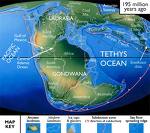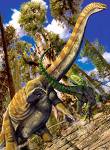The Jurassic Period 208 - 145 Million Years Ago
Homepage > Age of the Dinosaurs - Jurassic Period
The Jurassic period (about 208 - 145 MYA) marked the middle of the Mesozoic Era. By this time the supercontinent Pangaea was breaking up in earnest. Africa began to split from South America, and India prepared to drift toward Asia. Climates were now warm world wide, and moist winds from invading seas brought rain to inland deserts. Plants spread into once barren lands, providing plentiful food for abundant and widespread dinosaurs.
 Jurassic
Lands
Jurassic
Lands
As the Supercontinent Pangaea started splitting up, new mountains formed.
Floods of lava oozed from geological rifts that ran all the way from southern
Africa through Antarctica into Tasmania. Episodes of mountain building
wracked western North America, and volcanoes pushed up in the Andes.
During the Jurassic, Tibet joined Eurasia, and, as the period ended, Africa brushed against southern Europe, losing chunks of crust that formed portions of land as far apart as Arabia and Spain.
Jurassic Plants
Jurassic lands were generally greener and more lush than they had ever
been in Triassic times, and vegetation types were more uniform worldwide.
Tall forests conifers included relatives of today's giant sequoias, pines,
and Chile pine. Other plentiful trees included ginkgoes, while plamlike
cycadeoids were the main small trees and shrubby plants. In conifer forests
tall tree ferns often made up the understory The most common low growing
plants were ferns and horsetails. These grew prolifically and may have
been important as food source for sauropod dinosaurs. No flowering plants
appeared yet.
 Life
on Land
Life
on Land
In the early Jurassic, the main plant eating vertebrates were prosauropod
and ornithischian dinosaurs, and small, mammal like reptiles. But, by
Late Jurassic times, huge sauropods predominated. These browsed on both
high and low level vegetation.
Sauropods relied mainly on swallowed stones rather than teeth to pulverize their food. Stegosaurus, the next most abundant herbivore, had toothless beaks and weak cheek teeth. There were also ornithopods. Large theropods killed and ate herbivores, but small game or may have scavenged.
Life in the Air
The skin winged pterosaurs dominated life in the air. Rhamphorhynchoid
pterosaurs had a long tail that served as a stabilizer and rudder. Pteraodactyloid
pterosaurs lacked a tail. Many of these creatures had spiky teeth, adapted
for spearing fish as they swooped low over water. Early birds also appeared.
The best known, Archaeopteryx, had bones, teeth, and claws that resembled
a small theropod's, but also had feathered wings and tail and was capable
of flight.
 Life
in the Water
Life
in the Water
By the Jurassic period, both nothosaurus and placodonts had died out,
but ichthyosaurs persisted. They shared shallow seas with a group of marine
crocodilians whose limbs had also evolved into flippers, and with teleosts.
Other sea creatures included barrel bodied plesiosaurs, which traveled through the water like sea lions, and pliosaurs, which were short necked plesiosaurs with big heads and strong, sharp teeth. By Late Jurassic times, ichthyosaurs and marine crocodilians were in decline.